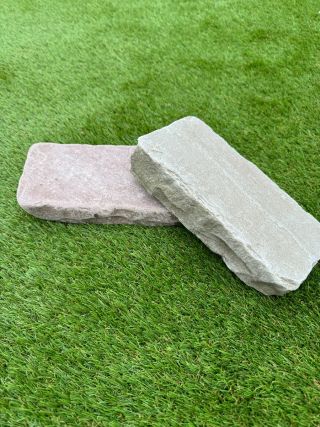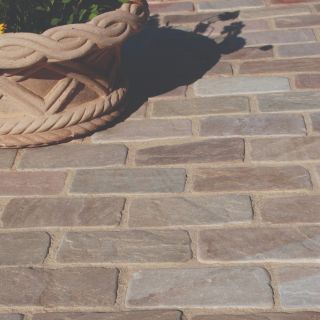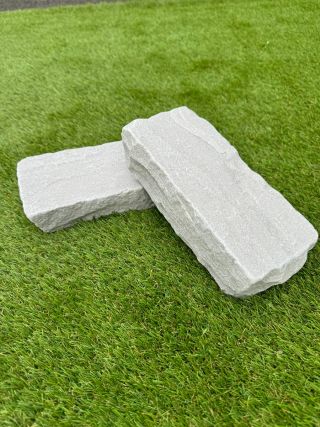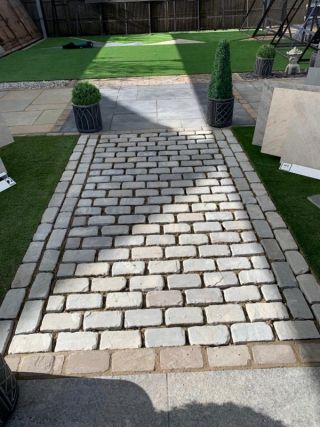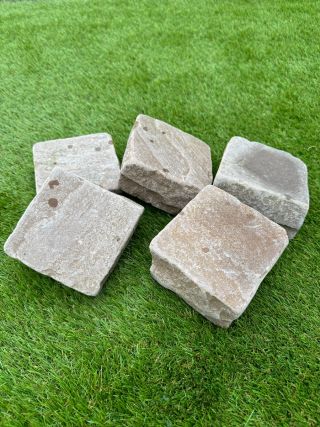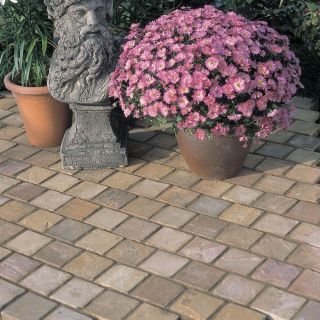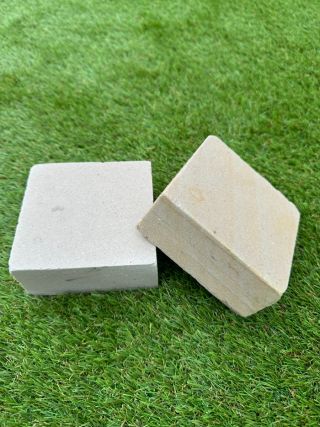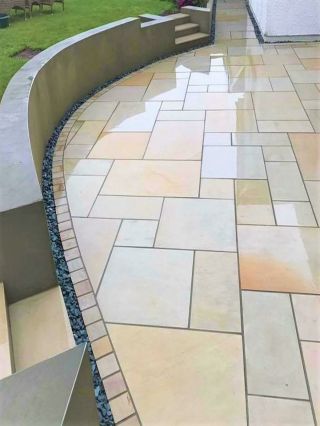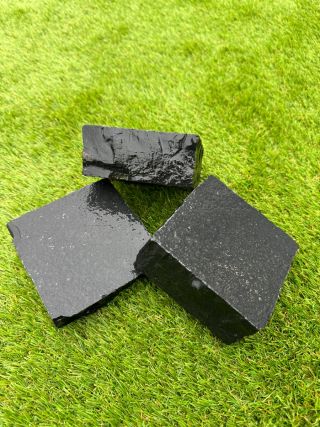Tumbled Cobble Setts
Whether you are looking to set boundaries between your paving slabs and grass areas with path edging or looking to use them for a driveway here at Melton Stone we can help.
They also offer practical benefits with keeping your garden areas looking clean with their cobble lines edging the patios or paths. These cobbles also helps to keep the other paving stable and helps to keep foot traffic within the confines of the edging.
Speak to a member of our friendly sales team today on 01482 688008 or Email sales@meltonstone.co.uk
Tumbled Cobble Setts
Can I park my car on cobble set driveway?
Yes, you can park your car on a cobble set driveway, but there are some important factors to consider to ensure the driveway can withstand the weight and pressure of the vehicle over time:
1. Cobble Sett Thickness: Make sure the cobble setts used for the driveway are of sufficient thickness to handle the weight of the vehicle. Thicker cobble setts, typically around 50mm (2 inches) or more, are more suitable for driveways with vehicular traffic.
2. Base Preparation: The foundation or base beneath the cobble setts is crucial for supporting the weight of the car. The base should be properly compacted, well-drained, and designed to handle the load.
3. Grouting: The joints between the cobble setts should be filled with a suitable grouting material to provide stability and prevent movement of the setts due to the weight of the car.
4. Edge Restraints: Proper edge restraints, such as concrete kerbs or metal edging, can help keep the cobble setts in place and prevent spreading or displacement caused by vehicle weight.
5. Proper Installation: Ensure that the cobble setts are installed correctly and according to industry standards to create a stable and durable driveway surface.
6. Regular Maintenance: Regular maintenance is essential to keep the driveway in good condition. Inspect for any loose or damaged setts, and promptly repair or replace them as needed.
It's important to note that cobble set driveways can create a charming and aesthetically pleasing entrance to your property, but they may require more maintenance compared to other types of driveways. The natural variations and textures of cobble setts can add character and visual appeal to your driveway, but they may also require occasional cleaning to remove debris and prevent weed growth.
What size do sandstone cobbles come in?
Sandstone cobbles, also known as sandstone setts or sandstone pavers, are available in various sizes to accommodate different design preferences and landscaping projects. The most common sizes of sandstone cobbles include:
100mm x 100mm (approximately 4 inches x 4 inches)
100mm x 200mm (approximately 4 inches x 8 inches)
150mm x 150mm (approximately 6 inches x 6 inches)
200mm x 200mm (approximately 8 inches x 8 inches)
200mm x 300mm (approximately 8 inches x 12 inches)
300mm x 300mm (approximately 12 inches x 12 inches)
These sizes are some of the most common dimensions for sandstone cobbles, but other sizes may also be available depending on the supplier or manufacturer. The choice of cobble size often depends on the specific project requirements, the layout, and the design intent.
Sandstone cobbles are typically used for various outdoor applications, such as driveways, patios, pathways, and garden edging. The varied sizes allow for creative designs and different laying patterns, giving homeowners and landscapers flexibility in creating unique and visually appealing surfaces.
How thick are Indian Sandstone cobble setts?
The thickness of Indian sandstone cobble setts can vary depending on the specific product and the manufacturer. However, typical Indian sandstone cobble setts are commonly available in thicknesses ranging from approximately 30mm (1.2 inches) to 50mm (2 inches).
The most common thicknesses for Indian sandstone cobble setts are 40mm (1.6 inches) and 50mm (2 inches). These thicknesses are suitable for most outdoor applications, including driveways, patios, pathways, and other landscaping projects.
When choosing the thickness of Indian sandstone cobble setts, consider the intended use and the level of foot or vehicular traffic the area will experience. For heavily trafficked areas like driveways, a thicker cobble sett is generally preferred to withstand the weight and pressure.
How to grout Indian sandstone block sett cobbles?
Grouting Indian sandstone block sett cobbles is a crucial step in the installation process that helps stabilize the cobbles, prevent weed growth, and provide a finished appearance. Here's a step-by-step guide on how to grout Indian sandstone block sett cobbles:
Materials Needed:
- Polymeric sand or jointing compound suitable for natural stone
- Soft-bristle brush or broom
- Water
- Rubber mallet or tamper (optional)
Step 1: Prepare the Surface
Ensure that the cobbles are laid firmly and evenly on a compacted and level base. Check for any loose or unstable cobbles and reposition them if necessary. Make sure the surface is clean and free of debris.
Step 2: Choose the Grout
Select a polymeric sand or jointing compound suitable for natural stone installations. Follow the manufacturer's instructions for the specific product you have chosen.
Step 3: Wet the Surface (Optional)
Some polymeric sands require a damp surface before application. Check the product guidelines to determine if wetting the surface is necessary.
Step 4: Fill the Joints
Pour the polymeric sand or jointing compound over the cobbles, aiming to fill the joints completely. Use a soft-bristle brush or broom to sweep the grout into the joints. Work the grout back and forth until it is fully compacted.
Step 5: Remove Excess Grout
Once the joints are filled, use the brush or broom to remove any excess grout from the surface of the cobbles. This will help ensure a clean and uniform appearance.
Step 6: Compact the Grout (Optional)
If required by the product instructions, use a rubber mallet or tamper to lightly tap the cobbles to further compact the grout and settle it into the joints.
Step 7: Clean the Surface
Carefully clean the surface of the cobbles with water and a sponge to remove any remaining residue from the grouting process. Avoid excessive water that could wash out the grout from the joints.
Step 8: Allow to Cure
Follow the manufacturer's guidelines for curing time. Polymeric sand or jointing compounds typically require moisture to activate the binding agents, and the grout needs time to set properly.
Step 9: Repeat (If Necessary)
If any joints appear low or have settled during the curing process, add additional grout to fill these gaps.
Step 10: Final Inspection
Inspect the grouted cobbles to ensure that all joints are adequately filled and the surface is even and level. Make any necessary touch-ups or adjustments before the grout fully cures.
Remember to follow the specific instructions provided by the manufacturer of the polymeric sand or jointing compound you are using, as different products may have varying application methods and curing times. Properly grouted Indian sandstone block sett cobbles will enhance the durability and appearance of your paved surface, providing a long-lasting and attractive outdoor feature.
What colours are available in sandstone cobbles?
Sandstone cobbles are available in a variety of natural colours, offering a wide range of options to suit different design preferences and landscaping projects. Some common colours available in sandstone cobbles include:
1. Buff or Beige: Buff or beige sandstone cobbles are among the most popular choices. They provide a warm and neutral colour option that complements various architectural styles and outdoor settings.
2. Grey: Grey sandstone cobbles come in shades ranging from light grey to charcoal grey. They can create a modern and contemporary look, blending well with both traditional and modern landscapes.
3. Brown: Brown sandstone cobbles offer earthy and warm tones, adding richness and depth to the paving. They can create a natural and inviting atmosphere in outdoor spaces.
4. Red and Rust: Some sandstone cobbles exhibit red or rust tones, providing a bold and vibrant option for adding character to patios and garden paths.
5. Multi-Colour Blends: Sandstone cobbles are also available in multi-colour blends, such as a mix of brown, beige, and grey, or a combination of various earthy tones. These blends offer a more diverse and visually appealing paving option.
It's important to note that the specific colours available in sandstone cobbles can vary depending on the quarry source and the region where the sandstone is mined. Natural stone always exhibits unique characteristics, and the colours may be influenced by the mineral content and geological factors. When selecting sandstone cobbles, it's recommended to view samples or images from your chosen supplier to get a better sense of the colours and their visual impact in different lighting conditions. This will help you choose the perfect collar option that complements your landscape design and matches your aesthetic preferences.

